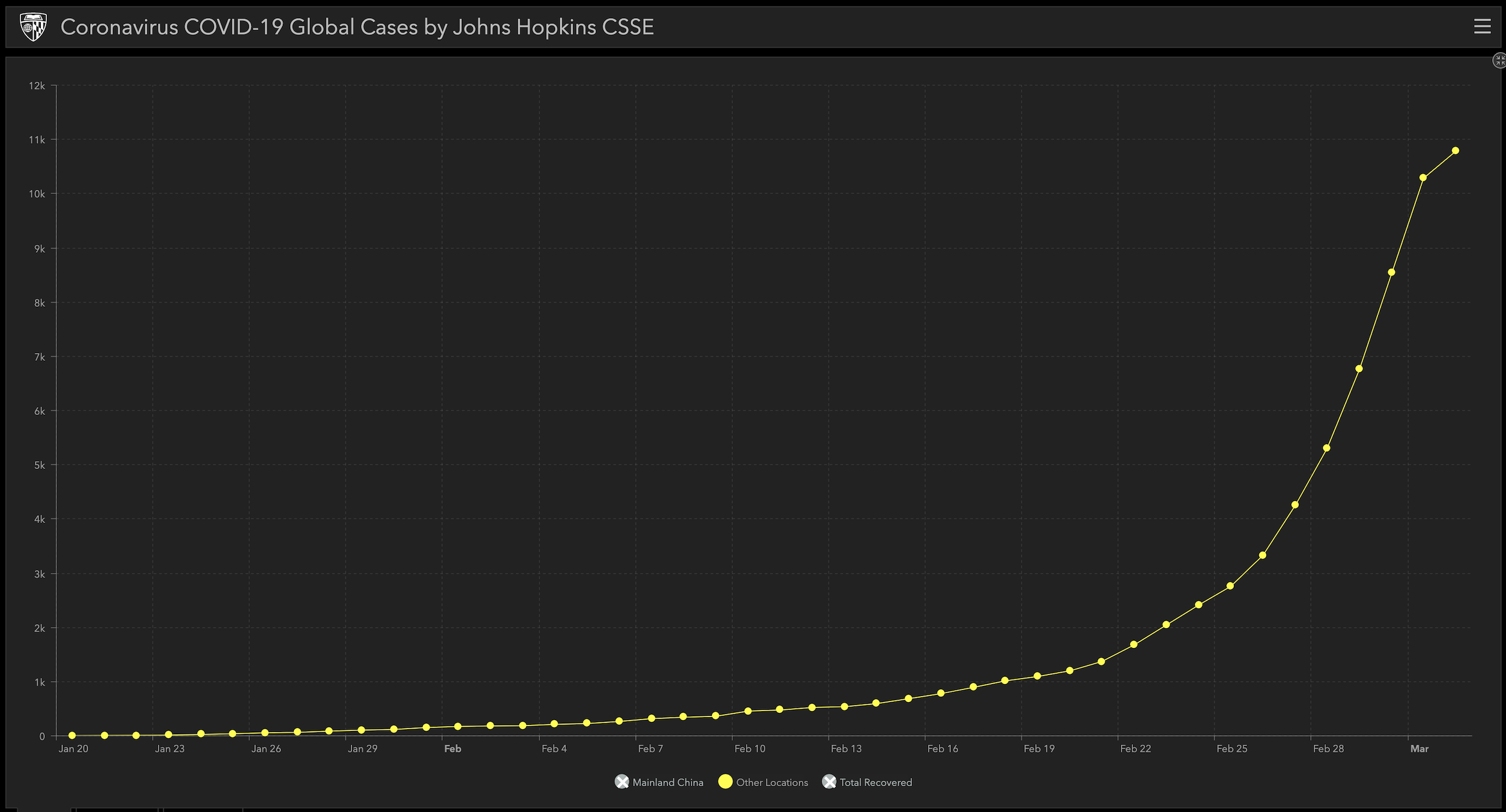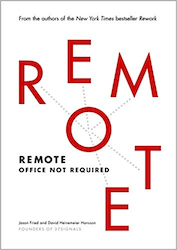Welcome To Remote Work

The Trigger
As of March 2nd, 2020, the coronavirus outbreak has officially hit the tech sector. The virus, SARS-CoV-19, causes the disease, COVID-19. There are several different strains of the virus at this point, as it mutates at an average of about two mutations per month, resulting in several different strains in different places. [source]. There is a rash of cases in the Seattle area, with a smaller number reported in a host of other places, including California and the Bay Area.

COVID-19 Global Cases, ex-China. Data by Johns Hopkins CSSE
Elad Gil published an excellent post about the impact of the virus on tech companies, including detailed but readable background information on the virus and it’s spread. Some useful Twitter accounts to follow are in the resources section below. Most important things to remember (summarized from Elad’s post):
- We will likely see a widespread outbreak of COVID-19. However, most cases will be mild, and most people will recover.
- Symptoms manifest between 3-14 days from exposure, including fever, cough, and shortness of breath. [Mayo clinic]
- Case Fatality Rate (CFR: deaths / people infected) is estimated at 2-3% but could be much lower, with better healthcare. People over 60 have a higher risk, as do patients with existing cardiovascular disease, diabetes, chronic respiratory disease, hypertension, and cancer. [source] There have been no reported fatalities in infants and children. [source]
- R0 value estimate is between 2 and 3. Every infected person will likely infect 2-3 more. In contrast, flu R0 is about 1.5. [source]
[Edit March 2021] In hindsight, using the below mnemonic was insensitive. When it was written, it tied the site of the biggest early infection to what people should do. In retrospect, after the term “China” was co-opted as a vehicle for racial hatred, it is wrong.
Quarantine and focused personal hygiene appear to be our best defenses against the virus at this point. Use the WUHAN mnemonic as a reminder:
W - Wash hands with soap frequently. [YouTube]
U - Use a mask if you are sick and infected.
H - Have your temperature taken daily if you have been exposed.
A - Avoid large crowds and gatherings.
N - Never touch your face with your hands.
The Response
Tech companies are starting to take action to protect their employees. I expect this trend to continue and accelerate over the next week. The responses generally follow the same principles:
- Minimize or cancel all work-related travel.
- Cancel large conferences and gatherings.
- Stay home if you exhibit any symptoms or believe you have been exposed to COVID-19.
- Working from home is encouraged for everyone and mandatory for critical employees.
- Interviews are over video instead of in-person.
Sources: Stripe’s public post, Twitter’s post, Coronavirus company response tracker
The Shift To Remote
COVID-19 represents a watershed moment for how we work. Tech companies have been trying to figure out how to move more of their workforce to remote, to take advantage of talent pools outside of major hubs like San Francisco, New York, and Seattle. Most companies that start in one location advance step-by-step, moving toward a hub model, and some like Stripe, move to full remote in addition to having a central hub.
After the outbreak of the virus, no tech company has a real choice. Every company will become a remote-work company out of necessity. Leaders need to face the reality of not having everyone in the office — they should be proactive and not get caught flat-footed. Here are a few things to consider:
- Async Remote vs. Sync Remote. If your current culture is set up to work in one office, within one timezone, you should maintain the concept of “working hours” where everyone is present on Slack or Teams. Jumping to fully async remote, where everyone works any hours they like, might be too disruptive for your company’s flow.
- Check your tools. Do you have enough zoom licenses? How are you going to do 100 people conferences remotely? Do you have a way to do collaborative whiteboarding? Are you capable of visually providing design feedback?
- Dry run. If your company isn’t going full remote right away, you can still mandate staying home for a few days at a time, to work out the kinks. Do you have a process to deal with emergencies and outages? Do you have phone numbers in an easily accessible directory?
- Preserve culture. Every company has its customs and traditions, from Monday donuts to Friday beers. People celebrate achievements together, have ways of communicating and collaborating. Art — ranging from murals to laptop stickers — gives us a constant reminder of belonging and shared values. How will you preserve this when you don’t have a common place to meet? For example, Fil Fortes uses a green screen to change up the background and keep things fresh.
Good books on remote work include Jason Fried and David Heinemeier Hansson’s Remote: Office Not Required. The book not only makes a strong case for remote work (not required at the moment), but has several good tips, learned through experience.

Self and Family Care
There is a lot of information about COVID-19, and it’s evolving fast. The consensus at this time, for yourself and your family, seems to be the following:
- Be prepared for a self-quarantine of 14 days or more. Stock up on food. ThePrepared has an excellent guide to getting food. Note that a lot of vendors are running out due to the increased demand. There is a distinction between food that will last for a decade (of which there seems to be short supply) and food that will last for a year (which is available in most grocery stores and Costco). The sooner you buy, the better.
- Be prepared for medicine shortages. Supply chains will get affected, and there could be runs on common drugs. Get a 90-day supply of your medication.
- Wash hands regularly. Regular hand washing (say ABC twice) is one of the best defenses against the virus spreading. The primary entry points are eyes, mouth, and nose, but we touch them with our hands roughly 23 times per hour. Hand sanitizers are only useful if they are 60% alcohol, and you rub your hands for 20 seconds or more. They’re also out of stock (in the Bay Area.)
- Avoid large gatherings. Regularly wiping down commonly used surfaces, like door handles, will help prevent the spread of the disease in schools and other shared places.
I hope this has been helpful, and everyone stays healthy and safe.
Resources
- Elad’s advice for startups: https://docs.google.com/document/d/1hYPrTMKfcEFux2rETlK07TAmW1wAW3003a00YRDn9qw/edit
- GitHub data repo updated regularly from Johns Hopkins: https://github.com/CSSEGISandData/COVID-19
- WHO-China Joint Mission on COVID-19: https://www.who.int/docs/default-source/coronaviruse/who-china-joint-mission-on-covid-19-final-report.pdf
- ThePrepared guide on preparing: https://theprepared.com/wuhan-coronavirus/
Company plans
- Public list of all plans: https://docs.google.com/spreadsheets/d/1awyG207-dR8HfpZR2T4GrPqixdT5Rht-Ex04pZ1KLNk/edit#gid=0
- Stripe: https://stripe.com/newsroom/news/covid-19
- Twitter: https://blog.twitter.com/en_us/topics/company/2020/keeping-our-employees-and-partners-safe-during-coronavirus.html
Twitters to follow